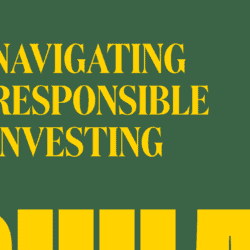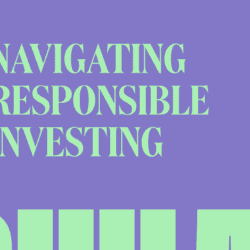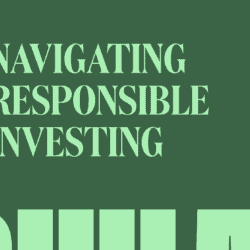The concept of generating positive benefits beyond just financial returns is particularly attractive to grantmaking foundations that steward endowments. But the president of Max Bell Foundation argues that a number of concerns about “responsible investing” make it premature to advocate that government should push charitable endowments in that direction.
The idea that investments could generate not only financial returns, but also positive social and/or environmental returns is broadly compelling. That’s evidenced by the growth of “responsible investing,” whether measured by sheer assets under management or by the remarkable (and growing) number of products available – especially to institutional investors.
The idea has become particularly attractive to grantmaking foundations that steward endowments. If it’s possible to achieve comparable returns with a comparable risk profile while at the same time generating positive social or environmental impacts – well, why wouldn’t you? Many have gone a step further, suggesting that government should enact policy measures to push charitable endowments into the responsible investing space.
This is the first in a series of three articles that sets out to examine these ideas. I will propose that, despite its promise, a number of concerns about responsible investing make it premature to advocate that government should push anyone, let alone charitable endowments, in that direction. The second article, co-authored by Chad Park and Greg Elliott, will show that it can be done – a large grantmaking organization can credibly move into a responsible investing space. The third article, from Tim Harper, will tackle some of the unresolved issues.
Why wouldn’t you?
The imperative to invest responsibly, or invest with impact, seems simple enough on the face of it. But those who have critically examined the space have several concerns. Individual entities will grapple with any or all of these as they consider how best to approach responsible investing in a way that makes sense for their own organizations. But I would argue that given these concerns, it’s premature to call for government action that would incentivize charitable endowments to place some or all of their assets in responsible investments.
Incoherence
What does “impact” or “responsible” investing actually mean? Different terms get bandied about, often uncritically, including “sustainable investing,” “impact investing,” “responsible investing,” “ethical investing,” and “environmental, social, and governance (ESG) investing.” The recent Responsible Investment Identification Framework published by the Canadian Investment Funds Standards Committee offers some guidance to the complexity, but the existence of a glossary – even a good one – may not do much to help investors understand and evaluate the multiplying number of approaches and products being marketed to them. Individual investors can decide for themselves how to navigate the complexity as the market and related standards evolve. The problem arises if governments move now to compel charitable foundations into a space that, for the moment, is poorly defined.
Greenwashing (or “woke-washing”)
Given the growing interest in these offerings, there are economic incentives for exaggerating the positive attributes of investments. Tariq Fancy, former CIO for sustainable investing at BlackRock (among others) has made the case that the finance industry is fundamentally incapable of delivering on the promise of responsible investing. Fancy’s argument is a simple one: incentives matter, and financial incentives trump, time and again, any others. Sophisticated investors who “look under the hood” as part of their regular diligence are growing suspicious about ESG claims made by the industry. For example, many institutional investment firms divested (and made a show of it) from companies domiciled in the Russian Federation only after the February 2022 invasion of Ukraine. Some of their clients have been asking why they hadn’t moved those funds following the 2014 invasion of the Crimean Peninsula.
Measurement problem 1: Inconsistent metrics
The overall field may be improving, but at the moment there is a variety of inconsistent metrics in use – sometimes layered together with subjective judgments, particularly about social and environmental impacts. (See this 2020 OECD report on the practices and challenges of ESG investing and “Why the Booming Business of ESG Ratings May Be Giving Investors a False Sense of Sustainability,” in The Globe and Mail.) Who decides what’s “ethical” or “responsible”? Even where there are tangible impact measures with credible accounting methodologies, such as with greenhouse gas emissions, who decides what is the most effective and responsible investment strategy for achieving outcomes (i.e., emission reductions)? Is outright divestment from fossil fuels a better strategy than transition financing to help legacy industries decarbonize? (See page 13 of this report from the Smart Prosperity Institute.) On this thorny question, rating agencies may be of little help. A special report published by The Economist in July called ESG rating agencies “the veritable acme of inconsistency.” Again, individual investors can decide whether they have the capacity to assess what metrics matter to them and what strategies they believe will be most effective. For governments to push charitable endowments into that space, however, would be an error.
Measurement problem 2: The missing baseline
Proponents of responsible investing will often demonstrate that it can be done without compromising financial returns. While (as noted above) the metrics used may be inconsistent, many will also aim to demonstrate a positive social or environmental return. What they don’t typically do is then compare the social or environmental returns on “business as usual” investing. The unspoken assumption is that mainstream investing has zero (or even negative) social or environmental effect. That’s an assumption that should be tested. Investing in Government of Canada bonds, for example, enhances the federal government’s capacity to deliver an enormous range of positive environmental and social impacts. It could be argued that investing in Canadian “small-cap” stocks (companies with relatively small market capitalizations) strengthens Canada’s economy, which has a range of powerful and far-reaching positive knock-on effects on prosperity, employment, a robust tax base for wealth redistribution, et cetera. I would suggest that wise investors who commit to some form of responsible investing should at least be curious to measure not only what positive social or environmental benefits accrue, but also – and more important – how that compares to the social or environmental benefits that accrue to business as usual. For governments, the bar should be higher. Any policy action intended to incentivize the movement of charitable endowment funds into responsible investing should be based on a clear demonstration that doing so will yield better social and environmental outcomes than mainstream investments.
Limited capacity and lack of intermediaries
Few endowments in Canada are large enough to have the in-house expertise required to develop and deliver on a responsible investing strategy. Larger endowments that seek to engage at scale in responsible investing need to rely on intermediaries to connect efficiently with the demand side of the market. In Canada, the intermediary functions available – especially for the “impact investing” market (i.e., specific opportunities at the firm or project level, including preferential-rate mortgages; community bonds, essentially pooled low-rate loan funds; and social impact bonds, essentially pay-for-performance contracts) – remain “fragmented and at small scale.” Pushing endowments to engage in these markets without the required capacity and expertise would be a recipe for frustration and chaos.
Limited pipeline
On the demand side of the market, in Canada there is still a relatively small pipeline of opportunities for impact investing. Depending on the specificity of the social or environmental objectives an investor seeks alignment with, that pipeline may be even smaller. A majority of Canadian charities are not interested in participating as debt issuers largely because they lack the capacity to manage debt instruments and have significant concerns about their ability to repay. The market may grow over time, but requiring foundations to invest in today’s limited market would essentially restrict their investment universe.
Jurisdiction
Federal government authority to regulate charities flows through the Income Tax Act and the provisions therein related to taxation. The “prudent investor standard” in most provincial trustee acts provides latitude for endowments to invest some of their assets in “responsible investments,” but it’s far from clear that the federal (or any) government could require them to do so. Even if it could, government would then face the thorny question of defining what a “responsible investment” is.
And yet …
As this list of concerns demonstrates, entering the responsible investing space presents serious challenges. And yet, many have boldly gone forward. As I noted at the outset, the case for doing so is compelling. The foundation that employs me – Max Bell Foundation – has gone forward with a mixed approach. We require our managers to maintain their good standing as signatories to the UN Principles for Responsible Investment. And we maintain a modest allocation to project-level impact investments like social impact bonds and microlending. We’re learning as we go.
So to be clear, my argument isn’t against responsible investing. I believe grantmaking foundations that steward endowments should seek to understand the space, and should assess for themselves whether and how it’s appropriate for them to engage.
What I am against is advocating to government to take policy action to try to push charitable endowments toward responsible investing. The space is chaotic, it presents many challenges that those with less capacity cannot reasonably overcome, and the net positive social or environmental outcomes are too uncertain. Using public policy to push regulated entities like charitable endowments into the space would be, in my view, irresponsible.


